Ubunchu! - The End
As mentioned in my recent article, at least 15 chapters of the Ubunchu! manga appear to have been created, along with a few special chapters1. The official English translations, available on GitLab, only cover chapters 1 through 8, but chapters 9 through 13 (or possibly 14) can be found elsewhere.

Surprisingly, I recently came across a translation of chapter 15, released by a random group just two months ago. This is unexpected, considering Ubunchu! was originally published until around 2013 or 2014. The content of chapters 12–14 appears to be set between 2010 and 2011, covering key events such as:
- The release of Linux Mint’s Debian Edition (introduced in September 2010).
- The LibreOffice/OpenOffice split, which began when Oracle acquired Sun Microsystems in September 2010. The open source community’s disagreement with Oracle’s handling of OpenOffice led to the creation of LibreOffice. As of June 2011, Oracle donated OpenOffice to the Apache Software Foundation, leading to the birth of Apache OpenOffice.
The final chapter of Ubunchu! was centered on Ubuntu Touch, which Canonical developed from January 2013 (when it was first introduced) until April 20172, when they discontinued it alongside Unity 8.
I just finished reading the chapter, and it was an interesting one. The story is framed around Ubuntu Touch and how it was installed on an Android tablet belonging to the school I.T. club. The main focus was on uncovering who installed Ubuntu Touch on their tablet, but it also served as a teaching experience to highlight its benefits. The story was framed around the fact that Ubuntu Touch was a work in progress — a date in one of the panels was May 22, 2013 (which I imagine is when the artist stopped working on Ubunchu) — just a few months after Canonical released a preview version of Ubuntu Touch for Nexus devices.
 The ironic part of this final Ubunchu chapter was that the school I.T. club president, a known Windows user who dislikes Linux and is a rival to Akane - the system admin club, complained about the Windows 8 touch interface at the beginning of the chapter, and the vice president of the I.T. club was advising her that she should be more open about change. As the chapter progresses there is a part that seemed a bit out-of-character where she seemed content using an Android tablet — despite Android using the Linux kernel.
The ironic part of this final Ubunchu chapter was that the school I.T. club president, a known Windows user who dislikes Linux and is a rival to Akane - the system admin club, complained about the Windows 8 touch interface at the beginning of the chapter, and the vice president of the I.T. club was advising her that she should be more open about change. As the chapter progresses there is a part that seemed a bit out-of-character where she seemed content using an Android tablet — despite Android using the Linux kernel.
Looking back, it’s disappointing that even now, no mainstream device truly delivers on the vision Ubuntu Touch had for its Convergence feature — where plugging in a monitor, keyboard, and mouse instantly gives you a desktop experience. Instead, we have devices like the iPad, which, while powerful, runs iOS, rather than a full blown desktop3.
Interestingly, Nicco from Nicco Loves Linux recently covered this same topic in a video, exploring how Android could be used as a Linux desktop. If there were a proper implementation of the Convergence feature on Android, I’d be tempted to switch. Samsung and Motorola have made attempts — Samsung with DeX and Motorola with Ready For, but it seems that DeX, is limited to Samsung’s flagship phones, and DeX seems like the better solution between these two. My Galaxy Tab A8 probably doesn’t support it since it was a $250 tablet, and it appears that DeX is restricted to top-tier phones. From what I’ve seen in Mike O’Brien’s video, DeX basically turns Android into a ChromeOS-like interface on a monitor. What is cool is that when you connect a Samsung device using DeX, you can use the smartphone as a trackpad.
In contrast, Ubuntu’s Convergence offered a distinct mobile interface that transformed into a full desktop user interface when connected to external peripherals — this demo is a good example. Motorola’s Ready For also seems impressive, but I’m not entirely sure of its current status or whether it functions like Convergence and DeX, or something else entirely.
Android Police indicates that while both DeX and Ready For offer solid desktop-style experiences4 they have limitations and aren’t full Linux desktops in line with what Convergence was promising.
-
This GitLab repo has preview covers of the special chapters, but it is hard to tell what they are about, unlike the regular chapters which at least hint at it. The special chapters look to be slice-of-like stories based on what is visible. ↩︎
-
Ubuntu Touch lives on through UBports, a community-driven project that continues development. As of now, UBports is based on Ubuntu 20.04, meaning it’s technically running a five-year-old version of Ubuntu. ↩︎
-
Depending on the iPad, the monitor might act as simply a mirror of the iPad’s display. iPad Air and Pro devices, on the other hand, use the external monitor as a secondary screen, although I am not sure if it is limited to one or more external displays. ↩︎
-
This article is from Oct. 2023, so the information might be out-dated, there is some indications elsewhere that Motorola has abandoned Ready For and is using some sort of solution where you can cast the Android phone onto a Lenovo laptop - I guess this is perfect example of corporate synergy since Lenovo owns Motorola. ↩︎